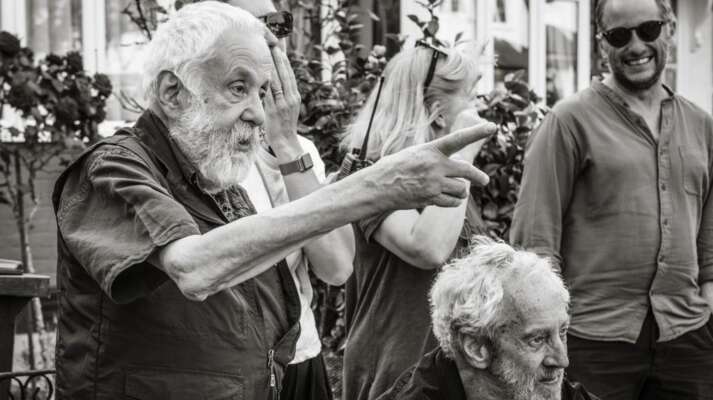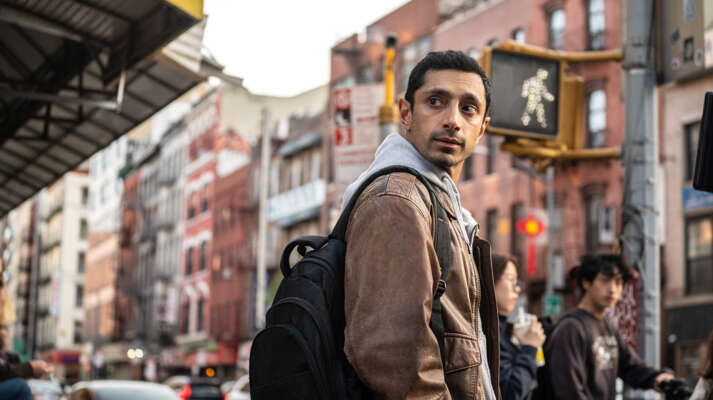The Journey is the Destination
CAPTAIN FANTASTIC joins other great films in which the inspiring landscape outside sets the course for the journey inward.
The Journey is the Destination
Written by Peter Bowen
CAPTAIN FANTASTIC | A Family In The Woods
In Matt Ross’ CAPTAIN FANTASTIC, Ben Cash (Viggo Mortensen) uses the wilds of the Pacific Northwest to provide a natural classroom in which to teach his children about the world around them. In addition to a strenuous course of hiking and running, the young actors learned what it takes to live off the land. “They were taught how to make a fire, skin a deer, track an animal and rock climb, as well as basic martial-arts skills,” explains Ross. Cash’s plan, and Ross’ film, recreate a classic American journey, a sojourn into nature to learn about one’s self. In Walden, Henry David Thoreau spells out plainly what this entails: “I went to the woods because I wished to live deliberately, to front only the essential facts of life, and see if I could not learn what it had to teach, and not, when I came to die, discover that I had not lived.” From Stéphane Fontaine’s soaring cinematography to the hand-hewn compound created by production designer Russell Barnes, the filmmakers turned this dream into a reality. But Cash’s experience in the woods does not simply provide a classroom for the kids; it also takes Mortensen’s character––and the audience as well––on a powerful journey to understand what it means to raise a family on one’s own terms. We take a short trek to explore other films in which characters and families journey into the wild, often getting lost, but finally finding a way to redefine who they are and where their destiny lays.
 Wild | Reclaiming the Past
Wild | Reclaiming the Past
In 1995, when Cherryl Strayed was 26, she took off on a three-month journey that would change her life. Walking 1,100 miles of the Pacific Crest Trail, she was forced to confront her grief over her mother’s death from cancer, her alcohol and drug abuse, her self-destructive behavior, and most of all herself. “At the end of the hike I had nothing but student-loan debt and 20 cents,” Strayed tells The Telegraph. “And I was completely OK. I was better than OK. Which is not a narrative we hear often, especially with women.” But it was the story that she wanted to tell, and in 2012, Wild: From Lost to Found on the Pacific Crest Trail was published. The story was juggernaut, receiving rave reviews, reviving Oprah’s book club, getting translated into 32 languages, and selling over 1.75 million copies. Even before it hit bookstores, Reese Witherspoon had optioned it for a film. While there are moments of personal triumph and natural beauty along the way, Strayed’s journey is also quite brutal, both its bruising physical exertion and in the maelstrom of violence, depression, and drug abuse that preceded it. But for its fans, its honesty, brutal and otherwise, transported it into an instant classic. The New York Times’ Dani Shapiro called the book "spectacular... at once a breathtaking adventure tale and a profound meditation on the nature of grief and survival, ... both a literary and human triumph.” For the film, Nick Hornby was hired to write the screenplay with Jean-Marc Vallée––who’d recently helmed Dallas Buyers Club––directing. For producer and star Witherspoon, the majesty of the wilderness would be essential to understanding the drama: “I loved the idea of learning these great big life lessons and what you can learn from life in this beautiful environment of the Pacific Northwest.” In the film, the visual contrast between the world she walked through and the inner journey she was bound on helped chart her emotional journey. While she learns to put herself “in the way of beauty,” as The New York Times’ critic A. O. Scott points out, the story is also about “her appetite for difficulty and her insistence on confronting ugliness, inside and out.” For Entertainment Weekly’s Tina Jordan, “The visceral scenes that follow of her promiscuity, heroin use, and crumbling marriage all make a terrible sort of sense. This isn’t a journey of redemption—it’s one of salvation.” For Witherspoon, who received both an Academy Award and Golden Globe nomination for her performance, the film provided both.
 Into The Wild | The Open-Ended Road
Into The Wild | The Open-Ended Road
On September 6, 1992, a group of moose hunters in Alaska stumbled across the corpse of a young man in a rusting bus just outside the border of Denali National Park. Later identified as Christopher McCandless, age 24, his death, and more importantly his life, became the inspiration for a book, then a movie, about one man’s struggle to redefine his life against the powerful canvas of the American wilderness. Soon after the event made national headlines, Jon Krakauer was hired by Outside Magazine to find out who this man was and how he ended up there. His 1993 article, “Death of an Innocent,” became the basis for his 1996 best-selling book Into The Wild, a remarkable non-fiction adventure that intentionally asks more questions than it provides answers for. After examining McCandless’ youth, and especially his decision after graduating from Emory University to donate the remaining $20,000 of his college fund to Oxfam and head west, Into The Wild follows its young hero through his myriad attempts to get back to nature, eventually leading to his decision to head north to Alaska. For Krakauer, McCandless embarked on this “raw, transcendent experience” to order to invent a new life for himself. While it ended in tragedy, the ideals it embodied inspired thousands, including director Sean Penn. “From the time I read the book, shortly after it came out in `96, I knew I wanted to make this movie,” Sean Penn told PopMatters. Soon after getting the McCandless family on board with his vision, Penn recalls how another dream shut down his: "I got a call at five a.m. from the mother, who had had a dream that implied to her that her son didn't want a movie made.” Penn had to wait over a decade before the McCandless family changed its mind. Writing the script himself, Penn transformed the story into a non-linear adventure that explored a series of topics and moments. With Emile Hirsch as the lead, Penn shot in 36 locations, hoping to reflect a visual reality that matched McCandless’ own journey. Showcasing the grand natural landscapes though which McCandless moved without making them mean more or less than what they were became essential to realizing the book’s power. “Nature in the raw is rarely shown in the movies to exist on its own account without an overt dramatic function,” notes The Guardian critic Peter Bradshaw. “This picture lets nature simply be; it lets nothing happen, and does not insist on a dramatic storyline of depression or anger leading to McCandless's death. This is an event that just happens.” In so doing, it presents a landscape open to journeys. For The Washington Post’s Ann Hornaday, “Into the Wild is a big, beautiful picture, all the more so for inviting everyone, regardless of political position or philosophical bent, to see themselves.”
 The Way | The Spiritual Road
The Way | The Spiritual Road
Emilio Estevez's 2011 drama The Way follows Tom (Martin Sheen), a slightly uptight Midwestern ophthalmologist, who travels to Spain after his son (Emilio Estevez) dies in the Pyrenees while walking El Camino De Santiago, the ancient pilgrimage route that goes from Southern France to the shrine of St. James in Northwestern Spain’s Santiago de Compostela. Still grieving and a bit lost, Tom decides to walk the 30-day trek that his son was about to start as a tribute to his lost child. The theme of family inheritance and indebtedness defined the film’s production as well as its story. While on a hiatus from The West Wing in 2003, Sheen embarked with his grandson, Taylor Estevez (Emilio’s son), on the ancient pilgrimage. But halfway through, their journey was interrupted when Taylor met his future wife and moved to the town of Burgos along the Camino. As Estevez and Sheen started traveling there to met their new family, they embarked on a journey of their own, talking about the pilgrimage, their family, their heritage, and their faith, themes that would percolate in Estevez’ imagination to inspire the film. Eventually the story of another journey, The Wizard of Oz, helped Estervez structure his screenplay. Imagining his father’s character as Dorothy, Estervez created three other pilgrims to join him on their way to the shrine: an overweight Dutchman (Yorick van Wageningen), a Canadian fleeing an abusive relationship (Deborah Kara Unger), and a blocked Irish writer (James Nesbitt). Along the way, Tom finds a way to confront his son’s death by becoming “a father to them in many ways that he was never able to be a father to Daniel,” Estevez tells CBN. For each of them, their real pilgrimage begins by accepting who they are, not who they want to be.“The whole journey is about showing our brokenness,’ Sheen explains to The Telegraph. “That’s what spirituality really is. It’s humanity.” Against the backdrop of the rugged Spanish mountains and plains, each traveler finds their own way. In experiencing his memories and “a gorgeous landscape,” explains Empire’s Angie Errigo, “Tom finds himself looking inwards and letting himself experience the journey itself.”
 The Emerald Forest | To the Edge of the World
The Emerald Forest | To the Edge of the World
John Boorman’s 1985 adventure The Emerald Forest weaves together several real-life stories about children disappearing in the Amazonian jungle to create its own fictional tale of abduction. In the film, Bill Markham (Powers Boothe), an engineer hired to construct a hydroelectric dam, finds his life turned upside down when his seven-year-old son, Tommy, is kidnapped one afternoon. The film picks up 10 years later. The dam, a project that has dramatically disrupted the jungle ecology and its tribal economies, is done, but Markham stays on to find his son. Tommy––now called Tomme (and played by Boorman’s own son, Charley)––is a full-fledged member of a tribe called the Invisible People. Fully immersed in the rituals, ways and myths of the tribe, Tomme has nearly no memory of his past life––until by accident he saves the life of his father who is being attacked by a savage tribe named the Fierce People. The father and son, now standing on opposites sides of a cultural divide, must find a way to reconnect for the sake of the jungle. A dense and heady brew of political thriller, ecological allegory, anthropological exploration, and family melodrama, The Emerald Forest uses the personal journeys of the separated father and son to meditate on fate of the wilderness and the nature of civilization. “‘The edge of the world’ is a place that exists quite literally in John Boorman's films,” wrote The New York Times critic Janet Maslin. And in The Emerald Forest, it’s “a place of fierce, perilous beauty.” The film also provided a journey for the director father and his son, who previously had had a rocky relationship. Despite fierce opposition from the film’s screenwriter, Rospo Pallenberg, Boorman cast his son, partially because he felt Charley’s own difficulties, especially as someone dealing with dyslexia, would speak to the character. “He was in some ways more immature than many kids his age," Boorman told People. "Yet in a curious way that made him more like the boy in the film. Charley can relate much more to a nonliterate society." But casting his son was also personal to Boorman as a father: “I understand how you bring up kids and protect them. Then suddenly they are grown and you have to find it in your heart to let them go."
 The Mosquito Coast | The Dark Journey
The Mosquito Coast | The Dark Journey
In Peter Weir’s The Mosquito Coast, Allie Fox (Harrison Ford) escapes the corruption of the American dream by taking his wife (played by Helen Mirren) and his four kids (including his eldest played by River Phoenix) to Central America to build his own dream community. Adapted by Paul Schrader from Paul Theroux’s critically acclaimed novel, the story echoes a classic theme that connects Walden to Swiss Family RobinsontoHuckleberry Finn, that of people yearning to recreate their lives far away from civilization. In his book review for The New York Times, Thomas R. Edwards notes that “in his rejection of America, Fox is of course a classic American type; and his will to create a new world for himself would have been understood at Brook Farm or Walden Pond or in any frontier homestead.” Shooting the film in the jungles of Belize, Weir and his team had to recreate the world anew for themselves as well. In American Film, Digby Diehl explains, “The company had to build roads into the jungle, support an entire small hospital for emergency help, coordinate with fifty local contractors who were accustomed to a leisurely Caribbean pace of life, and stay out of the myriad political skirmishes among the Belizeans, Guatemalans, Salvadoran refugees, and native Indians.” But Weir’s production recreates Fox’s journey only to illustrate the dark side of such utopian ambition. As The Philadelphia Inquirer critic Carrie Rickey points out, “Having rejected America because it ‘buys junk, sells junk and eats junk,’ Allie re-creates junkyard America in the uncharted ‘Mosquito Coast’ hamlet of Geronimo.” In the tropical paradise, Fox grows increasingly despotic and demanding about the way his family should live and how their new Eden should be cultivated, so much so that his son Charlie (Phoenix), who’d previously adored his genius dad, comes to fear him. As Variety sums up the film’s journey, “it starts out as a film about idealism and possibilities, but takes a dark turn and winds up questioning the very values it so powerfully presents.” For Weir, this dark journey reflects the operatic nature of the story and its character: “In opera, many times you start with everything wonderful, the songs bright and positive, and then the complexities arise and you end with tragedy"––a tragedy that earned Harrison Ford a Golden Globe nomination for his larger-than-life performance.


